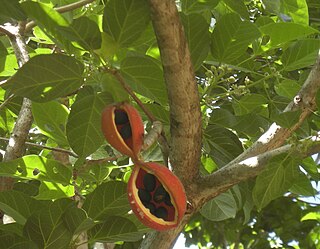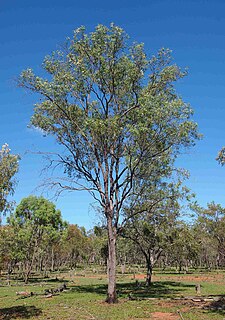
Eucalyptus regnans, known variously as mountain ash, swamp gum, or stringy gum, is a species of Eucalyptus native to Tasmania and the state of Victoria in southeastern Australia. It is the tallest flowering plant and one of the tallest trees in the world, second only to the coast redwood of North America. A straight-trunked tree with smooth grey bark, but with a stocking of rough brown bark from 5 to 20 metres above the ground, it regularly grows to 85 metres (280 ft), with the tallest living specimen, the Centurion in Tasmania, standing 100.5 metres tall. White flowers appear in autumn. Victorian botanist Ferdinand von Mueller described the species in 1871.

A stringybark can be any of the many Eucalyptus species which have thick, fibrous bark. Like all eucalypts, stringybarks belong to the family Myrtaceae. In exceptionally fertile locations some stringybark species (in particular messmate stringybark can be very large, reaching over 80 metres in height. More typically, stringybarks are medium-sized trees in the 10 to 40 metre range.

Eremophila is a genus of more than 260 species of plants in the figwort family, Scrophulariaceae all of which are endemic to mainland Australia.. Eremophilas are widespread in the arid areas of Australia, especially Western Australia and range in size from low-growing shrubs to small trees. The petals are joined, at least at their bases, into a tube with the upper petals different in size and shape from the lower ones. Some species have common names including emu bush, poverty bush or fuchsia bush, reflecting the belief that emus eat the fruit, their arid environment or a superficial resemblance to the flowers of plants in the genus Fuchsia.

Eucalyptus punctata, commonly known as grey gum, is a large tree of the myrtle family, Myrtaceae, native to South East Queensland and eastern New South Wales, where it specialises in poor soils such as Sydney sandstone. Its leaves are one of the favoured foods of the koala. The tree's common name comes from its bark, which takes a greyish cast at about one year of age. On most trees this bark is partly shed, revealing a bare and slightly orange or brown tinted smooth surface. The white flowers appear over the summer.

Totness Recreation Park is a protected area in the Australian state of South Australia located within the localities of Mount Barker and Totness in the central Mount Lofty Ranges. Covering 41 hectares of land, the park is divided by the South Eastern Freeway and features a large dam. It was declared as a reserve in 1970 and re-designated as a recreation park in 1972. The park has no visitor facilities except for access tracks. It is the only park in the district, managed by the Department of Environment and Water, that is solely designated for recreation.

Sterculia quadrifida, also known as the peanut tree, or red-fruited kurrajong is a small tree that grows in the rainforests, vine thickets and gallery forests of coastal Queensland, the Northern Territory and north-eastern New South Wales.

Persoonia longifolia, the upright snottygobble, also known as the long-leaf persoonia or just snottygobble, is a species of tall shrub or small tree in the plant genus Persoonia, reaching 1 to 5 metres (3–17 ft) in height. It is found in the Jarrah forests of southwest Western Australia. This species is characterised by its long narrow dark green leaves, dark yellow to orange flowers and distinctive flaky dark red bark.

Eucalyptus obliqua, commonly known as the brown top, brown top stringbark, messmate, messmate stringybark, stringybark or Tasmanian oak, is a hardwood tree native to south-eastern Australia.

Eucalyptus botryoides, commonly known as the Bangalay, bastard jarrah, woollybutt or Southern Mahogany, is a small to tall tree native to southeastern Australia. Reaching up to 40 metres high, it has rough bark on its trunk and branches. It is found on sandstone- or shale-based soils in open woodland, or on more sandy soils behind sand dunes. The white flowers appear in summer and autumn. It reproduces by resprouting from its woody lignotuber or epicormic buds after bushfire. E. botryoides hybridises with the Sydney blue gum in the Sydney region. The hard, durable wood has been used for panelling and flooring.

Mallee is the growth habit of certain eucalypt species that grow with multiple stems springing from an underground lignotuber, usually to a height of no more than 10 m (33 ft). It is most common in plants of the genus Eucalyptus, many of which naturally grow in a mallee habit, and some of which grow as single-stemmed trees initially, but recover in mallee form if burnt to the ground by bushfire. It also occurs in the closely related genera Corymbia and Angophora. The word "mallee" may also be used as a noun in reference to species or individual plants with a mallee habit.

Eucalyptus robusta, commonly known as swamp mahogany or swamp messmate, is a tree native to eastern Australia. Growing in swampy or waterlogged soils, it is up to 30 m (98 ft) high with thick spongy reddish brown bark and dark green broad leaves, which help form a dense canopy. The white to cream flowers appear in autumn and winter. The leaves are commonly eaten by insects, and are a food item for the koala. It is an important winter-flowering species in eastern Australia, and has been planted extensively in many countries around the world. Its timber is used for firewood and in general construction.

Eucalyptus tereticornis is a species of tree native to eastern Australia. E. tereticornis has several common names, including forest red gum, blue gum, flooded gum, grey gum, mountain gum, Queensland blue gum, red gum, bastard box, red ironbark, red irongum and slaty gum.

Psaltoda moerens, commonly known as the redeye, is an Australian species of cicada. It is distributed through the south-east of Australia, from southern Queensland to South Australia, as well as Tasmania. Populations can vary greatly between years; one year they may be present in large numbers and the next they may be entirely absent. They feed primarily on eucalyptus but also on Angophora trees. As they feed on tree sap they expel small droplets of clear waste fluid. When numbers are high, this can form a constant stream.

Homalanthus populifolius, the bleeding heart, native poplar or Queensland poplar, is an Australian rainforest plant in the family Euphorbiaceae. It often appears in areas of rainforest disturbance. Bleeding heart is highly regarded by rainforest regenerators because of its fast growth and use as a pioneer species in rainforest regeneration.

Eucalyptus oreades, commonly known as the Blue Mountains ash, is a species of eucalyptus native to eastern Australia.

Telopea oreades, commonly known as the Gippsland-, mountain- or Victorian waratah, is a large shrub or small tree in the family Proteaceae. Native to southeastern Australia, it is found in wet sclerophyll forest and rainforest on rich acidic soils high in organic matter. No subspecies are recognised, though a northern isolated population hybridises extensively with the Braidwood waratah (T. mongaensis). Reaching a height of up to 19 metres, T. oreades grows with a single trunk and erect habit. It has dark green leaves with prominent veins that are 11–28 centimetres (4.3–11 in) long and 1.5–6 cm (0.6–2.4 in) wide. The red flower heads, known as inflorescences, appear in late spring. Each is composed of up to 60 individual flowers.

Dichelachne crinita , commonly known as the longhair plume grass, is a type of grass found in Australia, New Zealand and islands of the Pacific Ocean. It is often seen on sandy soils near the sea as well as woodlands. The flowering panicles are open and feathery at maturity. The grass may grow up to 1.5 metres (5 ft) tall. Crinita, the specific epithet, is derived from Latin (hairy).



















